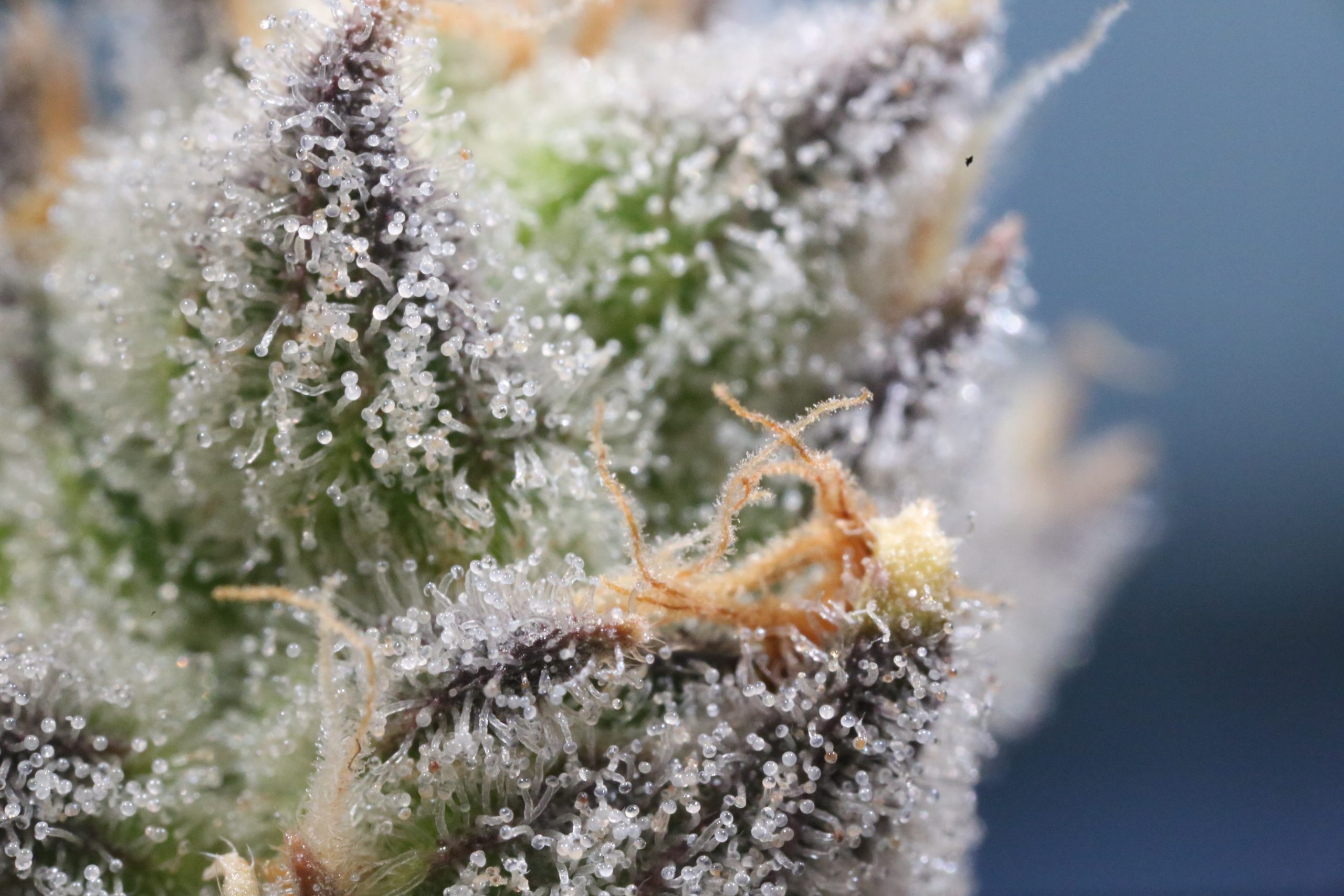You may have heard of cannabinoids like THC and CBD, but what about “terpenes?” These intriguing compounds play a major role in your cannabis products, influencing everything from how they smell and taste to how they make you feel. Understanding which terpenes are in your cannabis products and how they work can help you make more informed decisions when shopping at Queen City. To help you tell myrcene from limonene, we’ve created this terpenes guide detailing some of the most common terpenes in cannabis.
What are terpenes in cannabis?
Terpenes are plant-based volatile organic compounds known for their distinct smells and flavors. More than 200 terpenes have been identified across different strains of cannabis, but there are around 20,000 terpenes found in nature. These compounds are why cannabis can smell like fresh berries, pine floor cleaner, lemonade, or a bouquet of flowers, depending on the strain.
The role terpenes play in nature
Terpenes protect and support a plant in many ways throughout its life. Many terpenes provide antibacterial and antifungal properties that can help ward off diseases. Others dissuade pests and predators through their scents and tastes. Some terpenes attract pollinators and increase the likelihood they help the plant reproduce.
Interestingly, terpenes may also offer some beneficial effects to humans, which has prompted more research into their potential uses in medicine. These compounds can also change the way you feel after consuming cannabis, offering effects of their own and exerting an influence on how the cannabinoids found in that product work.
Want to learn more about the phytocannabinoids found in cannabis? Our cannabinoids guide provides an overview that can get you up to speed on these important compounds.
The effects cannabis terpenes may have on your experience
Terpenes may contribute to your cannabis experience in many ways, from potentially boosting pain-relieving qualities to promoting relaxation and stress relief. Many terpenes also include anti-inflammatory, antibacterial, antiviral, and antifungal effects, which makes sense since one of their main jobs in nature is to protect plants from disease.
How terpenes influence your experience depends on the “terpene profile,” or which terpenes are present and in what amounts. Generally, a terpene profile will have one clear dominant terpene alongside others. A common terpene profile you will encounter in cannabis, for example, is a myrcene-dominant blend that also contains high levels of limonene and beta-caryophyllene.
In addition to the terpene profile of a product, your biology matters. The terpene profile your friend prefers may not be the one that provides you with the best experience possible. Everybody is different and cannabis experiences can vary from person to person, so finding the best blend of terpenes to suit your palate and your session may take a bit of trial and error at first.
Common cannabis terpenes you’ll find in cannabis
Although there are more than 200 terpenes in cannabis, there are some that appear more frequently and in abundance. That’s because many of those 200-plus terpenes in the cannabis plant don’t make it to your final flower purchase. They evaporate at very low temperatures and often disappear before you get a chance to try the cannabis. Some also appear in such trace amounts that they are virtually unmeasurable.
Here are nine of the most common terpenes you’ll likely encounter when exploring a cannabis dispensary menu.
alpha-Pinene
- Smell: Pine, earthy
- Taste: Earthy, herbal
- Found in: Conifer trees, basil, eucalyptus, mint, rosemary
- Common strains: Blue Dream, Pineapple Express
Named for the pine trees in which it is found in such abundance, alpha-pinene makes it smell as though you’re taking a walk through the forest. It offers an earthy yet refreshing flavor with a cool, crisp quality. This terpene may help alleviate pain and promote relaxation.
beta-Caryophyllene
- Smell: Peppery, spicy
- Taste: Peppery, spicy
- Found in: Black pepper, cinnamon, cloves, hops
- Common strains: Sour Diesel, White Widow
Beta-caryophyllene shows up often in cannabis, bringing its spicy, peppery aroma and flavor to the mix. It’s no surprise this terpene is found in other plants with the same scents and tastes, like black pepper and cloves. Beta-caryophyllene is a special terpene that also acts like a cannabinoid in some ways, but more about that later. Researchers believe this terpene may help alleviate pain by impacting inflammation throughout your body.
Shop strains with caryophyllene like Blackberry Kush and Lemon Pound Cake from Queen City.
Myrcene
- Smell: Herbal, fruity
- Taste: Sweet, spicy
- Found in: Hops, lemongrass, mangoes, thyme
- Common strains: OG Kush, Grandaddy Purple
Myrcene is a rockstar in the cannabis world, appearing more frequently and in more abundance than any other cannabis terpene out there. This herbal terpene offers fruity smells with sweet flavors with hints of a pungent spice. Significant amounts of myrcene are also found in hops, alongside some other cannabis terpenes on this list. Myrcene has a reputation for relaxation and helping to promote deep, restful sleep.
Shop strains with myrcene like Sour Diesel and Northern Lights from Queen City.
Limonene
- Smell: Citrus
- Taste: Sweet, sour
- Found in: Citrus fruits, bergamot, caraway, dill
- Common strains: Wedding Cake, Tahoe OG
Limonene, as the name suggests, is found in citrus fruits like lemons and oranges — and it tastes and smells like it, too. This terpene acts as a powerful antibacterial agent, making it a go-to ingredient in household cleaners. Researchers believe it also serves as an antioxidant, which may reduce oxidative stress on your body.
Shop strains with limonene like Wedding Cake and Sherblato from Queen City.
Ocimene
- Smell: Floral, woody
- Taste: Fruity
- Found in: Basil, bergamot, mango, orchid
- Common strains: Jack Herer, Clementine
Ocimene is less common in cannabis than terpenes like myrcene, beta-caryophyllene, and limonene, but you shouldn’t count it out. When ocimene shows up in a terpene profile, you can expect it to contribute floral and woody aromas with fruity flavors. Ocimene may also offer an uplifting experience, along with antiviral and antifungal properties.
Shop strains with ocimene like Jungle Punch from Queen City.
Terpinolene
- Smell: Herbal, pine
- Taste: Sweet, sour
- Found in: Apple, cumin, nutmeg, tea tree
- Common strains: Golden Goat, Super Lemon Haze
Terpinolene is considered a minor terpene, yet its name will likely become familiar quickly if you examine cannabis products closely. Despite its status as a minor terpene, Terpinolene shows up often alongside myrcene, beta-caryophyllene, limonene, and pinene. Many consumers report that cannabis products with a high volume of terpinolene are relaxing and may help them fall asleep.
Shop strains with terpinolene like Mac N Jack from Queen City.
Humulene
- Smell: Earthy, hoppy
- Taste: Bitter, herbal
- Found in: Coriander, ginseng, hops, sage
- Common strains: GSC, Skywalker OG
Humulene is most recognizable for its hoppy smell and flavor, which should be no surprise since it is abundant in hops. This terpene is often cited as offering pain-relieving qualities, as well as an uplifting experience that may ease stress and boost mood. Humulene may also offer appetite-suppressant qualities.
Shop strains with humulene like Frozen Mangos and Punch Cookies from Queen City.
beta-Pinene
- Smell: Pine, woody
- Taste: Minty, woody
- Found in: Conifer trees, basil, dill, eucalyptus, rosemary
- Common strains: Blueberry, White Fire OG
The counterpart to alpha-pinene, beta-pinene offers some characteristics that make it unique despite their similar aromas and flavors. As an antibacterial and antimicrobial terpene, it excels at fighting off diseases in the plant and may translate some of these benefits to consumers as well. Beta-pinene is often described by consumers as a terpene that improves their mood and energy.
Shop strains with pinene like Sunshine Daydream and Blue Dream from Queen City.
Linalool
- Smell: Floral, sweet
- Taste: Floral, sweet, spicy
- Found in: Lavender, basil, rose
- Common strains: Amnesia Haze, Lavender Kush
Linalool is seldom present in high amounts, but it is often part of a cannabis product’s terpene profile. This sweet, floral terpene also comes with a bit of bite, which will be most familiar to consumers who enjoy lavender essential oils. Linalool is known as a relaxing terpene that can help you unwind at the end of a long day and slip into a restful sleep.
What does it mean when a weed strain is high in terpenes?
When you see that a strain is high in a certain terpene, that number is still quite low. Terpene levels as small as 1% can be considered high in that particular terpene. You’ll rarely find terpene content, of any terpene in any strain, reach more than 3% or so. Keep that in mind while evaluating flower terpene content.
Cannabis Terpenes chart: Compare terpenes easily
| Terpenes | Smell | Taste | Potential Effects |
Plants Found In |
| alpha-Pinene | Pine, earthy | Earthy, herbal | Pain relief, stress alleviation, anti-inflammatory | Conifer trees,
basil, eucalyptus, mint, rosemary |
| beta-Caryophyllene | Peppery, spicy | Peppery, spicy | Antibacterial, antimicrobial, antioxidant, anticonvulsant, stress alleviation | Black pepper, cinnamon, cloves, hops |
| Myrcene | Herbal, fruity | Sweet, spicy | Anti-inflammatory, pain relief, relaxing, sedating | Hops, lemongrass, mangoes, thyme |
| Limonene | Citrus | Sweet, sour | Antibacterial, antifungal, energizing, stress alleviation, uplifting | Citrus fruits, bergamot, caraway, dill |
| Ocimene | Floral, woody | Fruity | Anticonvulsant, antifungal, decongestant, expectorant | Basil, bergamot, mango, orchid |
| Terpinolene | Herbal, pine | Sweet, sour | Calming, energizing, uplifting | Apple, cumin, nutmeg, tea tree |
| Humulene | Earthy, hoppy | Bitter, herbal | Anti-inflammatory, antimicrobial, appetite-suppressant | Coriander, ginseng, hops, sage |
| beta-Pinene | Pine, woody | Minty, woody | Bronchodilation, pain relief, stress alleviation, anti-inflammatory | Conifer trees, basil, dill, eucalyptus, rosemary |
| Linalool | Floral, sweet | Floral, sweet, spicy | Relaxing, sedating | Lavender, basil, rose |
How to identify terpenes in your cannabis products
The best way to know which terpenes are in your cannabis product is to review test results on a product’s Certificate of Analysis. Licensed cannabis dispensaries in New Jersey must pass state testing standards before reaching store shelves, and those include testing for the nine terpenes listed above.
There are other ways to get a sense of the terpene profile of a product even without test results, though. There are countless sources online that post in-depth strain and product profiles, listing the typical terpene profile you can expect in each. It’s worth noting that terpene profiles can vary, even between flower of the same strain, so this method is only good for taking a ballpark guess. Still, it offers some useful insight when choosing a cannabis product.
In the absence of any information at all, you can rely on the nose test. The most notable characteristic of any terpene is its smell. An experienced nose may be able to detect with some accuracy which terpenes are most abundant, much like a sommelier can identify the components of wine. (In fact, there are “ganjiers” who specialize in this exact thing!) Of course, the accuracy of this method depends wholly on the knowledge and perception of the person smelling a product.
Are terpenes and cannabinoids the same thing?
Nope! Terpenes and cannabinoids are two separate compounds that coexist in the cannabis plant.
Do cannabis terpenes interact with your endocannabinoid system?
Most cannabis terpenes do not interact with the ECS the way that phytocannabinoids do, with one notable exception: beta-caryophyllene. Beta-caryophyllene is a “dietary cannabinoid” that selectively binds to the CB2 receptor of the ECS and activates it. Researchers have observed that beta-caryophyllene may reduce the production of pro-inflammatory cytokines, helping to reduce inflammation in your body.
Other terpenes work by altering the way phytocannabinoids engage with the ECS. For example, researchers have observed myrcene to increase permeability across the blood-brain barrier, which increases the amount of cannabinoids that reach your brain. Myrcene itself, though, does not bind to the cannabinoid receptors of the ECS.
Discover more about terpenes at Queen City Dispensary
Like most things in cannabis, we’re learning new information about terpenes all the time. At Queen City, we’re here to bring you the latest so we can help you choose the best cannabis products for your next session. If you want to know more about the terpene profile of any cannabis product we carry in our wide-ranging selection, our budtenders stand at the ready to help you do so. Stop by Queen City Dispensary in Plainfield, NJ, and see what makes us one of the best cannabis dispensaries in New Jersey!


